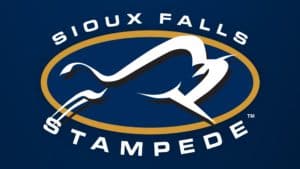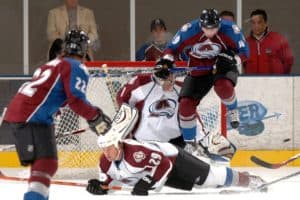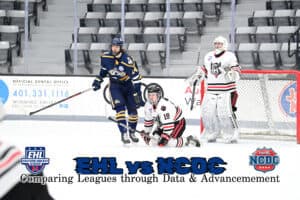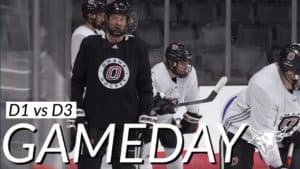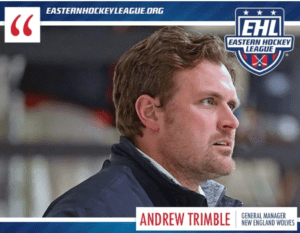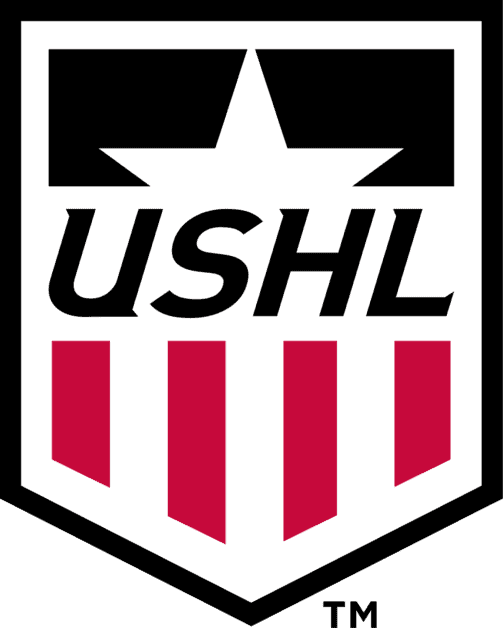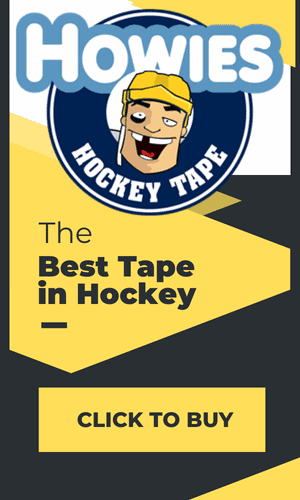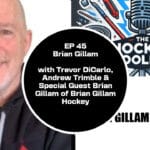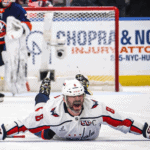We talk plenty about Junior (20U) hockey at TJHP. After all, Junior hockey is in our name. However, that’s not all we do. We also offer in-depth coverage of 16U, 18U, prep school, and competitive high school hockey. I’d like to kick off our “Midget” and prep/high school coverage with a long overview sprinkled with a little history. Midget hockey being defined as all USA Hockey (USAH) youth hockey post-14U. With the explosion of Junior hockey around the turn of the century prep schools took a minor hit in prominence but Tier I Midget hockey, and in some areas Tier II Midget hockey, almost disappeared outside of the Midwest. Part of that was due to status-oriented salesmanship: “If you’re good enough to play Junior hockey why play Midgets? Junior hockey is how you get to college … and by the way, we have a Junior roster spot for you.” It was nothing sinister, just a shift in marketing as rink-based travel programs started to overtake the traditional non-profit hockey clubs as the norm. The sales pitch was in high demand from the players and parents, so it was a two-way street. It allowed organizations to offer 3-4 Junior teams in lieu of Midget teams. What nobody ever seemed to figure out is that regardless of the Midget vs. High School vs. Prep School vs. Juniors arguments, the number of players at those levels never increased as a result. The pie was being cut into different sized pieces for each level but the pie can’t get bigger when talking about 15-20-year-old players. Left out of that sales pitch was the fact players are highly likely to matriculate to college only when they’re 20 years old, regardless of where they played. So, three years of Midget and two years of Juniors = five years of Junior. Time was the only thing that created 20-year-old players. Over the past decade, the pendulum has swung back toward Midget hockey with the 2004-05 creation of the 16U and 18U divisions by USAH. Until 2003-04 USAH offered Midget hockey up to 17U. One of the goals of the 18U level was to allow all high school seniors to continue playing club hockey through their final year of school. By creating 18U it also created a four-year Midget window for 15-18-year-olds, which was deemed too wide for the physicality and maturity of all the players, so USAH split the difference and created 16U. It took a few years for the 16U level to catch on as the top 15- and 16-year-olds immediately clamored to play 18U. This left the remaining 15- and 16-year-old players trying to figure out what to do, but eventually 16U gained traction has become a bastion of NCAA Division I and United States Hockey League (USHL) recruiting. USAH has also since added a 15U division which has also caught on around the country, providing a stable ladder of development for all Midget players regardless of how quickly they develop physically. The re-emergence of Midget hockey has its roots in the mid-1990s, which ironically was about the time it started to suffer. A private high school in southeastern Minnesota name Shattuck-St. Mary’s (SSM) was struggling on the ice and with overall enrollment numbers in the late 1980s. At one point, SSM went from being one of the worst teams in the Minnesota State High School League to a co-op team with Fairbault High School (the city in which SSM is located) that had only a couple of SSM players involved. SSM hockey was almost non-existent in 1989 (Source: Minnesota Vintage Hockey). The idea was hatched and executed to create a nationally renowned hockey program at SSM, which in turn would create a demand for school admissions, thereby solving two problems with one idea. The new SSM product didn’t burst on the hockey scene in 1990 with great prominence, but by 1999 it built a program that captured its first USA Hockey National Championship, coached by future NHL head coach Andy Murray. More importantly it became a desired destination for players all over the United States and Canada, including Sydney Crosby, Jonathan Toews and Zach Parise to name just a few of the distinguished alumni. SSM added 14U teams and a Girls Program in the years since, which has not only provided a broad college development program but bolstered admission numbers at the school. The SSM model was duplicated in 2011 when the South Kent School (Connecticut) and LEGACY Global Sports entered into an agreement to form South Kent Selects Academy (SKSA). South Kent dumped its traditional prep school hockey membership and created Tier I 16U and 18U (and later 15U) SKSA teams that play nationally competitive USAH teams across the country. SKSA won its first USA Hockey national championship in 2019 at the 18U level, but its teams have become regular attendees at the national competitions.

Devin Rask, who helped guide SKSA from prep school into a nationally competitive program, did such a bang-up job that he and his staff were successfully recruited to Mt. St. Charles Academy (Rhode Island) which shocked much of the prep school world by adopting an SSM-style program that hit this ice this fall. “The headmaster (at South Kent School) saw that the traditional three-sport athlete wasn’t the same as he was 20 years ago,” said Rask about his hiring process at SKSA. “Division I athletes are, and sports in general, are becoming more specialized. Not that (the headmaster) didn’t believe in the multi-sport athlete, he saw what was happening and made a change ahead of the game.” South Kent saw immediate success on the ice and eventually at the admissions office. “(Enrollment numbers due to hockey) didn’t go up much in the first year so, because they still had the prep team, but eventually we went to three teams and added 60-64 students compared to the 30-35 they used to have,” said Rask. “I think we all knew Shattuck was the model school for a program like this. They did it, they produced elite hockey athletes and they drove up their enrollment. In my mind, they were the marquee model.” While the ability to recruit and attract top-end players due to the nationally competitive schedule is great, Rask, like other coaches who are involved in these types of programs, instead raves about the player and personal development opportunity. “For me, the big piece is the development piece,” said Rask. “We are on the ice four days per week, we have off-ice development and a goalie coach. It’s not just hockey but all sports that get specialized at this age.” At Mt. St. Charles, which has a storied history and NHL alumni like Bryan Berard, Brian Boucher, and Garth Snow, Rask plans to keep the status quo with the way he and his staff execute. “I just want to carry on the tradition because it’s legendary with Coach Belisle and what he did here. That’s part of the reason I came to Mount — because of the tradition and legacy. High school hockey is changing and we want to lead the way into the future. Minnesota high school hockey has been able to continue (its stature) but on the East Coast, it’s changing. If you drive two or three hours in any direction you can find dozens of Junior, Midget, and prep school options. There is just so much.” Another offshoot in the re-emergence of Midget hockey was started by Thunder AAA Hockey, which made famous the “weekend model” for hockey clubs. As the sport developed in non-traditional areas – like the Southeastern District where Thunder AAA Hockey was based — it became difficult for the elite-level players to stay home and play if they wanted to continue to develop. There simply weren’t enough local players or interest to fashion a competitive Tier I program. Enter Nathan Bowen, a former University of Alabama-Huntsville and minor league professional player, settled in Huntsville after graduating college and commenced coaching hockey. Bowen could see the raging growth in the Southeast and he put together a program that allowed players in different locales to all play on the same team. In what the Thunder called a “multi-city model,” the Tier I program used the weekends for the teams to get together for practice and competition, by gathering in Huntsville, Atlanta and Nashville for High Performance Weekends or games, or by everyone meeting for a tournament at another venue. During the week the players were on their own for individual skill development that was offered in each area. The Thunder’s model was successful, not just on the ice but for families and players looking for the Tier I option without sending their kid off to the Northland to billet. Thunder AAA Hockey was comprised of 90 percent players within the Southern Amateur Hockey Association, the USAH Affiliate for Alabama, Arkansas, Georgia, Louisiana, Mississippi, and Tennessee, while another five percent were from within the Southeastern District. The Thunder weren’t about recruiting and billeting but providing opportunity within the southeastern United States. “The Thunder merged with the Nashville Jr. Predators this past summer but we had 17 alumni participating in (last week’s) NAHL Showcase (in Blaine, Minn.),” said Bowen by email. “That’s a pretty cool stat to see the work paying off for the players.” Bowen also started Total Package Hockey in 2001, which is a year-round training and hockey service provider that now has nationwide franchises. Many Thunder AAA Hockey players trained with TPH during the week and during the off-season while competing for the Thunder. Finally, we have academy-style Midget hockey, which is where all the players are recruited to a certain locale where they live, train and participate in online schooling of some sort. This model allows for daily, daytime practices, when rinks generally have otherwise unsellable ice, and flexibility to set game schedules with few parameters. The Skipjacks Hockey Club, which is based at the York City Ice Arena in York, Pa., has become a prominent academy-style program over the last six years while the South Florida Academy has also entered the fray with a staff laden with former NHL players.

“When we started the Skipjacks in Maryland, we had half our players local and half our players billeted,” said Jared Kersner, co-owner and head coach of the Skipjacks. “Half our guys were doing online school and training the rest of the day in the gym or extra ice time. We figured why not do it that way 100 percent and have all our guys doing it that way.” Kersner and his brother, Jason, a longtime Midget, and former North American Hockey League head coach, sought out York because of the smaller community size, the ease of working with the municipally owned twin-sheet arena, and the economics of operating in an area like York. The Skipjacks exist purely on a development basis for players. They do not register as national-bound teams and play league games in the United States Premier Hockey League (USPHL) while attending various other showcases for exposure and competition purposes. “We bring the players into York the last weekend of August and we put them in a full-service environment until the end of February when the USPHL playoffs end,” said Kersner. “All our players do online schooling and we have four hours per day of study hall with paid tutors available at all times. That way players can go back homes and their home schools to finish out the year each spring. We have an intense program but we keep it to six months.” All three of the program styles covered, in addition to the traditional local Tier I team model, have been producing hundreds of NCAA Division I commitments and United States Hockey League (USHL) and NAHL draft picks for the past decade. As hockey continues to evolve there will be no doubt more programs and innovators to enter the picture and keep the hockey development moving forward. Looking for more insight with TJHP? Check out our FAQ page to learn more. EDITORIAL DISCLOSURE: The Skipjacks Hockey Club is a client of the author’s sports management company.

